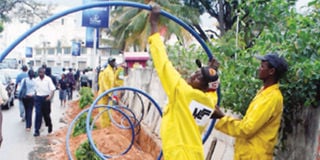Optic cables give Kenya a boost in web access

PHOTO | FILE From undersea cable stations in Mombasa, data is delivered to consumers through terrestrial networks.
What you need to know:
- Web Index, was funded by Google and spearheaded by World Wide Web inventor Tim Berners-Lee
- Report ranks countries based on Internet usage
- Globally, Sweden is ranked first, with excellent scores in all the seven categories
- Kenya leads in Africa in the economic impact of the web
Kenya has been ranked top in Africa in terms of economic impact of the Internet, according to a recent report released by World Wide Web Foundation.
Economic impact of the web is among the key components in the study that also assesses the extent to which Internet affects the economy and business in countries.
The new report, Web Index, was funded by Google and spearheaded by World Wide Web inventor Tim Berners-Lee. It ranks countries based on Internet usage.
Web Index is the first of its kind and weighs nations’ strengths in terms of seven key components, namely economic impact, communication infrastructure, web use, web content, political impact, and social impact.
Globally, Sweden is ranked first, with excellent scores in all the seven categories.
The report reveals that most African states, especially those in the hinterland are at the bottom in terms of the important aspects that dictate substantial Internet access. Zimbabwe trails the global list, with poor scores. Ethiopia, Namibia, Benin, and Burkina Faso are in the best bottom 10, too.
There is evidence of gain in access issues marked by an exponential growth of web usage in African countries where under-sea cable technology has been adopted and linked well to the -mile infrastructure.
Under-sea cables provide a boost in web access and this is evident in Kenya, Mauritius, Egypt, South Africa, and Tunisia.
Kenya has four undersea cables — EASSy, TEAMS, SEACOM, and LION-2 — linking her to the global digital world. Initially, Kenya relied on satellite access, but bandwidth and cost issues were a hindrance to growth in web access.
Signal transmission
Under-sea cable technology relies on advanced signal transmission techniques to relay data via hair-thin strands of fibre glass.
The fibre optic cables run from coast to coast, spanning thousands of kilometres on the sea bed.
Information is transmitted at the speed of light with a shorter latency compared to satellite communication.
The advantages of under-sea optic cables include bigger bandwidth, minimal signal interference, high speed data access, reliability, and scalability.
Under-sea fibre optic connections imply that Kenya is linked via landing stations in Mombasa to hot spots of business and information in Europe, Asia, the Middle East, and South Africa. This is an evolution from costly and limited bandwidth satellite communication.
Many developed countries have several reliable submarine cables that purvey information from one region to another.
From the under-sea cable stations in Mombasa, the data is delivered to the users through terrestrial networks.
This kind of fast connectivity has created a digital superhighway that enhances utilisation of broadband services and stimulation of economic growth.
Under-sea cable, as an emerging technology on the Kenyan ICT scene, is a catalyst in bridging the digital divide. Kenya’s score in the Web Index report could have been a different story altogether if the country had still been in the “dark days” that were punctuated with over-reliance on satellite Internet access.
The Communications Commission of Kenya’s quarterly reports show incremental adoption of Internet over the years. Access stands at 30 per cent, with approximately 11.8 million Internet users. The international connectivity bandwidth has also increased since the inception of the under-sea cable technology.
Utilisation of the large bandwidth, however, faces hurdles in the -mile infrastructure. Internet penetration and pricing are yet to rhyme with the connectivity delivered on the ocean shores by under-sea cables.
In the Web Index report, Kenya leads in Africa in the economic impact of the web, but scores averagely in other components, say, -mile infrastructure, a limitation that excludes millions of citizens from the digital world.
The author is an ICT analyst and a telecommunication engineer.




